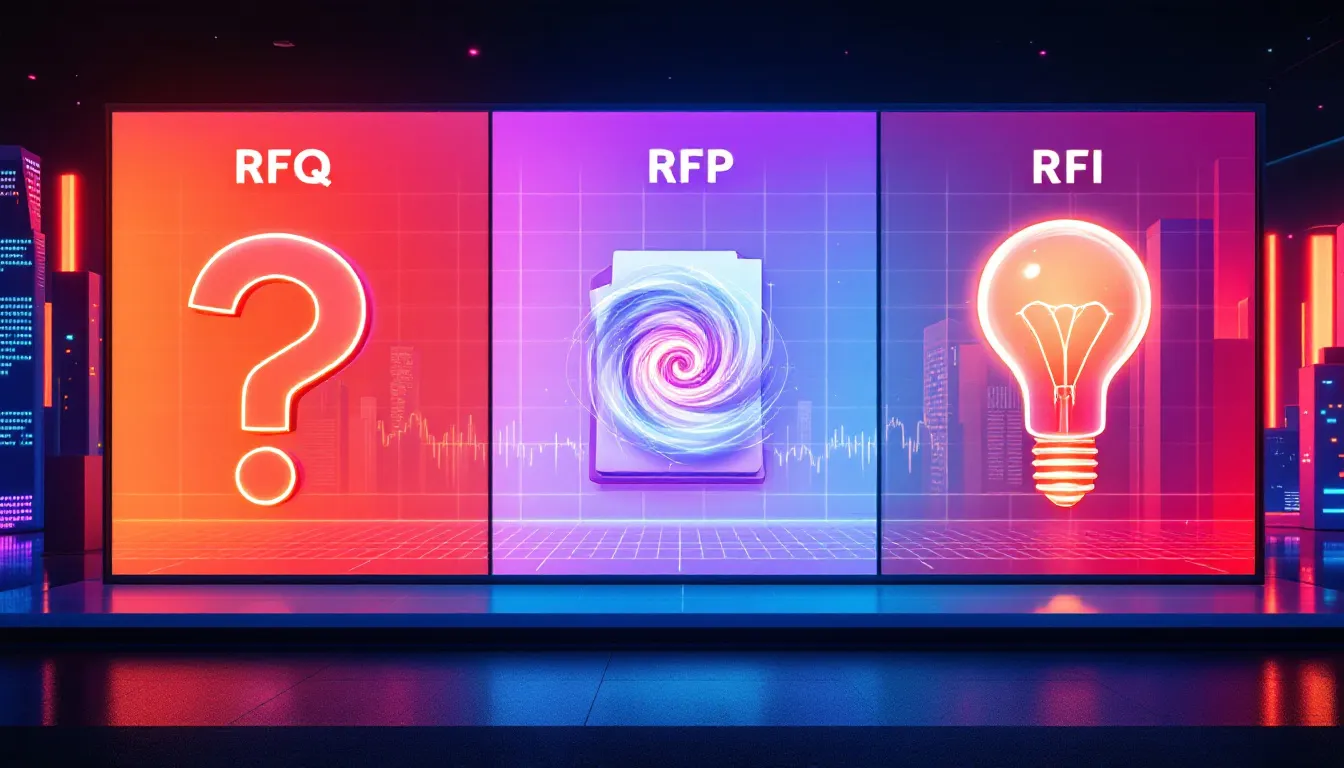Mastering the Request for Qualifications: A Comprehensive Guide
Table of Contents
A Request for Qualifications (RFQ) is used in construction to prequalify contractors before they submit full proposals. It helps organizations and government entities identify the most qualified contractors or suppliers based on their skills and experience. This guide will explain the purpose of RFQs, who uses them, and their benefits.
Understanding the Request for Qualifications (RFQ)

A Request for Qualifications (RFQ) is a vital component of the procurement process. It is a method for vendors to bid for construction work and is primarily used to prequalify contractors before issuing a Request for Proposal (RFP). This allows organizations to identify and screen potential suppliers based on their qualifications and capabilities, ensuring that only the most suitable candidates proceed to the next stage of the bidding process.
RFQs are commonly used by government agencies, construction project owners, and nonprofit organizations. These entities rely on RFQs to ensure compliance with regulations, gather pricing information, and solicit qualifications from vendors. The RFQ process offers several benefits, including more competitive pricing, streamlined bid comparisons, and quicker responses from top companies.
Related: How to Get Construction Project Leads.
Definition and Purpose
A Request for Qualifications (RFQ) is a document that asks contractors to detail their background and experience. The primary goal is to prequalify vendors or contractors based on their qualifications, capabilities, and experience before inviting them to submit detailed proposals. This ensures that the buyer focuses on the vendor’s skills and experience, ultimately leading to more informed decisions and successful project outcomes. A qualifications request is essential in this process.
Who Uses RFQs?
Various organizations use RFQs, including government agencies, construction project owners, and nonprofit organizations. Government agencies commonly issue RFQs to ensure compliance with regulations and solicit bids from qualified contractors.
Construction project owners and general contractors use RFQs to gather pricing information and prequalify suppliers for specific projects. Nonprofit organizations also rely on RFQs as part of their procurement efforts to ensure they select the most capable vendors.
Related: Guide to General Condition of Contract in Construction.
Benefits of Using RFQs
The RFQ process serves as an effective screening tool to identify capable professionals, streamlining the selection and solicitation process for contract awards. RFQs gather detailed information from multiple vendors, leading to more competitive pricing and easier bid comparisons due to a consistent format.
Additionally, best-in-class companies can respond to RFQs 36% faster than average, highlighting the importance of quick replies for efficient procurement.
RFQ vs RFP vs RFI

In construction, requests for qualifications (RFQs), requests for information (RFIs), and requests for proposals (RFPs) each play distinct roles in the project lifecycle. An RFQ is issued to assess a firm’s qualifications to determine if it has the necessary experience, skills, and capacity for the project. It helps the project owner shortlist companies by evaluating aspects like past project experience, licenses, and financial stability.
Related: How to Write a Winning Construction Request for Proposal (RFP).
An RFI, on the other hand, is a formal inquiry for additional information or clarification on project details, often used by contractors or subcontractors to clarify specifications, drawings, or requirements once a project is underway or in the planning stages. Lastly, an RFP is issued by project owners to solicit detailed proposals, including pricing and project approach, from qualified vendors who are interested in executing the project.
RFPs typically require responses on how the bidder plans to meet project specifications, timelines, and budgets, allowing owners to compare solutions and select the best fit for their needs. Together, these requests guide the pre-construction process and support informed decision-making for all parties involved.
Related: The Ultimate Guide to Risk Mitigation.
Key Components of an RFQ
A well-structured RFQ is essential for successful procurement. It serves as a communication tool used by project owners to gather pricing from vendors capable of fulfilling specific project requirements. An RFQ typically includes several essential components, such as project details, contractor qualifications, and submission requirements.
These components help shortlist potential qualified contractors and consultants based on their qualifications, enhancing visibility and managing responses effectively.
Project Details
Including detailed project information in an RFQ is crucial for vendors to provide accurate pricing and capabilities. This section typically includes guidelines, scope, requirements, and other essential details that provide clarity to potential suppliers.
The scope and requirements section often presents specific needs using charts detailing items, quantities, and descriptions, which are critical for accurate pricing. Additionally, including project budgets and timelines facilitates effective vendor selection and project execution.
Related: Why the Construction Industry Runs on Permit Data.
Contractor Qualifications
Stating clear objectives in an RFQ is essential as it defines intended outcomes and discourages submissions from unqualified contractors. Vendors are encouraged to present evidence of their capability to deliver required services when responding to an RFQ.
Evaluating a contractor’s delivery capability is crucial and may involve assessing their responses to specific questions in the RFQ.
Related: General Contractor Roles and Responsibilities Explained.
Submission Requirements
Submission requirements in an RFQ should specify deadlines, payment terms, and documentation necessary for the bidding process. Including deadline information helps vendors gauge response times and project delivery expectations.
Clear specifications in RFQs help suppliers deliver accurate quotes and ensure that all vendors have a clear understanding of the RFQ requirements. Prompt communication regarding RFQ requirements can prevent incorrect bids from vendors.
The RFQ Process

Managing the RFQ process effectively can significantly enhance the procurement team efficiency and overall project success. The process involves several phases, including preparation, issuing the RFQ, and evaluation and selection. Each phase is critical to ensuring that the RFQ process runs smoothly and yields the best possible outcomes.
Preparation Phase
Before creating an RFQ, it is essential to gather a list of requirements to ensure that all necessary information is included. The preparation phase should involve ensuring that all project-specific information, such as scope and timelines, is clearly outlined to maintain relevance.
Engaging stakeholders early in the RFQ preparation phase is crucial to gather diverse perspectives and avoid misunderstandings later in the process. Disregarding stakeholder input can significantly hinder the success of the procurement process, leading to misalignment on project expectations.
Issuing the RFQ
RFQs can be issued through various methods, including email, public announcements, or management software. Using RFP management software provides centralized communication and instant information sharing, streamlining the RFQ process. Engaging an RFP consultant can help maintain fairness and transparency in the process.
Prompt responses to vendor inquiries can prevent delays and ensure that suppliers understand the RFQ requirements.
Related: Understanding the Schedule of Values in Construction.
Evaluation and Selection
Evaluating RFQ responses ensures that bids are collected in a formal, structured, and comparable way. The typical outcome after issuing an RFQ is awarding the contract to the vendor meeting established criteria with the lowest bid. However, it’s a common misconception that the lowest price will always secure the contract.
Scoring the statements of qualifications (SOQs) helps identify clear front runners. Engaging stakeholders during the evaluation process provides input on scoring responses to subjective questions in RFQs.
Related: 4 Bid Reasons Contractors Prefer to Bid Digitally.
Tips for Effective RFQ Management

Effective RFQ management is imperative for success. Clear communication, detailed documentation, and timely responses are key elements. Consistent communication with vendors, maintaining thorough records, and ensuring prompt responses to inquiries are essential for a smooth RFQ process.
Clear Communication
Maintaining regular contact with bidders through various communication methods fosters stronger relationships. Not following up with contractors after issuing an RFQ can result in unanswered questions and potential misunderstandings. Addressing vendor inquiries and concerns promptly is essential to achieve competitive bids.
Clear and consistent communication with vendors is crucial for successful RFQ processes and ensuring a consistent supply.
Detailed Documentation
Maintaining thorough records of all communications and submissions is crucial for ensuring transparency in the RFQ process. Neglecting input from stakeholders can diminish accountability and transparency.
Ensuring that all documentation is accurate and comprehensive helps to uphold integrity and transparency in the RFQ process.
Timely Responses
Bidders should ask questions instead of submitting an incorrect bid if they do not understand the RFQ requirements. Contractors must thoroughly review the scope and requirements before replying to an RFQ. This ensures they fully understand the project expectations.
Submission deadlines should be selected with the understanding that selecting a winning offer may take longer than expected, allowing for sufficient time. If a vendor misses submission deadlines, it raises questions about their ability to handle the project.
Common Mistakes to Avoid in the RFQ Process

Common mistakes during the RFQ process can significantly affect the quality of vendor responses and the overall outcome of projects. Avoiding overly broad requirements, neglecting stakeholder input, and ensuring timely follow-up are key to a successful RFQ process. Here's an interesting statistic: 77% of proposal professionals say their proposal process isn't ideal. Get ahead of these common mistakes to avoid being in this statistic.
Overly Broad Requirements
Issuing a new round of RFQs may be necessary if the initial requirements are poorly defined. Overly broad requirements can lead to confusion among potential vendors and result in non-compliant submissions. Defining clear and specific requirements ensures that vendors can provide compliant and accurate submissions.
Ignoring Stakeholder Input
Feedback from stakeholders helps clarify project requirements and desired outcomes, leading to more effective RFQs. Stakeholder input ensures that all relevant perspectives are considered, avoiding misunderstandings and misaligned project goals. Effective stakeholder engagement is vital for the overall success and smooth execution of procurement projects.
Lack of Follow-Up
Following up with contractors after issuing an RFQ is essential for ensuring a clear understanding of the project requirements and expectations. Promptly addressing vendor questions or concerns helps clarify ambiguities and fosters positive relationships, promoting better responses in the RFQ process. Failing to follow up can lead to misunderstandings, increased errors in submissions, and potentially, the selection of unqualified vendors.
Best practices for effective follow-up communication include setting a timeline for responses, being accessible for questions, and sending reminders as needed.
Related: How Technology Can Help You Review New Construction Projects.
Summary

Mastering the Request for Qualification (RFQ) process is pivotal for successful procurement. By understanding the intricacies of RFQs, distinguishing them from RFIs and RFPs, and implementing best practices for effective RFQ management, organizations can streamline their procurement processes, foster competitive pricing, and ensure the selection of qualified vendors. Clear communication, detailed documentation, and timely responses are essential components that contribute to the overall success of the RFQ process. By avoiding common mistakes such as overly broad requirements and ignoring stakeholder input, organizations can enhance the quality of their vendor responses and achieve their project goals with greater efficiency.
See how Hubexo can help you get your RFQs in front of the right bidders.
Read similar posts on our blog page.
If you're a project owner or solicitor, click below to learn how we can help you easily advertise projects and get the best bids.
If you're a contractor or supplier, click below to easily search for and bid on projects and requests.
Frequently Asked Questions
What is the primary purpose of an RFQ?
The primary purpose of an RFQ is to prequalify suppliers or contractors by evaluating their qualifications, capabilities, and experience prior to inviting them to submit detailed proposals. This ensures that only competent candidates are considered for the project.
Who typically uses RFQs?
RFQs are typically utilized by government agencies, construction project owners, and nonprofit organizations to obtain pricing information from qualified vendors while ensuring regulatory compliance.
How does an RFQ differ from an RFP and an RFI?
An RFQ specifically focuses on obtaining cost estimates and prequalifying contractors based on detailed specifications, whereas an RFI is for general vendor information and an RFP seeks comprehensive proposals for complex projects.
What are the key components of an RFQ?
The key components of an RFQ are project details, contractor qualifications, and submission requirements. These components ensure accurate pricing and facilitate the selection of qualified vendors.
What common mistakes should be avoided in the RFQ process?
To ensure a successful RFQ process, avoid issuing overly broad requirements, neglecting stakeholder input, and failing to follow up with vendors. Clear and specific requirements, along with active engagement and follow-up, are essential.




